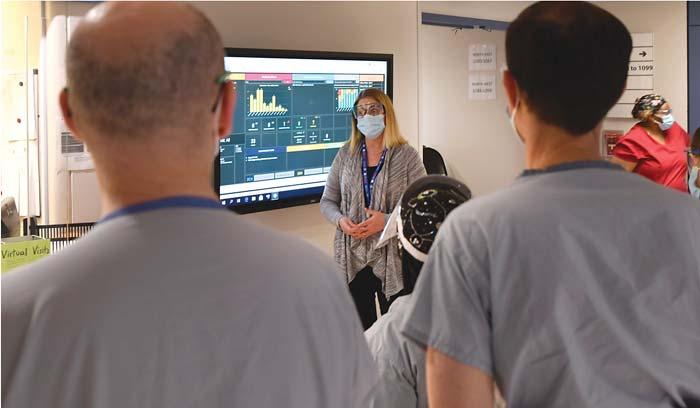
3 minute read
Osler’s iHuddle app facilitates team communication and collaboration
BRAMPTON, ONT. – Knowledge is power, and for managers and frontline healthcare workers, having access to real-time data at their fingertips can make all the difference in terms of sustaining and enhancing quality, patient safety and access to care. That was just one of the key drivers behind the development of William Osler Health System’s award-winning iHuddle Boards – a global leading practice as recognized by the Health Standards Organization (HSO) and Accreditation Canada.
Seeking a way to bring a consistent, organization-wide approach to quality improvement, and enhanced communication to regular team huddles across its three hospital sites, Osler undertook a refresh of unit-level huddle boards in late 2019.
The Quality and Organizational Performance teams mapped out their vision on a white board, posting desired metrics on pieces of paper and creating visual sections based on the organization’s four strategic directions.
Unit-specific metrics included number of falls, pressure injuries, patient safety incidents, real-time number of patients on the unit, number of pending transfers to the unit and number of confirmed and potential discharges.
Trending metrics showcasing monthly medication reconciliation on discharge, patient-reported experience metrics, hand hygiene and time to inpatient bed (90th percentile) were also incorporated.
The goal was to develop a communication tool that visually translated Osler’s strategic plan, as well as key quality, safety and performance metrics, in a manner that was meaningful to a breadth of stakeholders – from the frontline teams to the Executive Team and the Board of Directors.
Recognizing that manually updating information and metrics had its drawbacks,
Osler abandoned its unit-level white boards and magnets in November 2020 in favour of an innovative digital iHuddle board – a platform created in-house by Osler’s Information, Intelligence and Technical Innovation (IITI) team.
“Our ask of the IITI team was significant, as we wanted not only to standardize and share real-time metrics from multiple data sources to electronic huddle boards on each unit, we also wanted the boards to be interactive in nature, something we didn’t see at other hospitals when conducting an environmental scan,” said Tony Raso, associate vice president, Clinical Practice and Quality.
“We wanted managers and staff to be able to enter unit-specific information, such as staff recognition and the status of local quality improvement initiatives, as a way to further support communication, collaboration and timely decision-making.”
According to Osler’s Andreea Popescu, manager, Organizational Performance, the Quality and Organizational teams created a mock-up of what the digital version could look like. “We provided specifications for each metric, how it should be displayed, where the data should be pulled from, and how often it should be pulled. We gave the technical specs and design to our IITI team, who then developed the iHuddle App.”
Throughout its creation, the IITI team conducted iterations, validation and testing, piloting the iHuddle App on select inpatient units at Osler’s Brampton Civic Hospital and Etobicoke General Hospital prior to the broader organizational roll-out. Information is streamed via the iHuddle App to forty-three 55-inch touchscreen monitors in each Emergency Department, inpatient and outpatient area.
The roll-out was accompanied by robust resources and onboarding, including scripts, training and technical videos for directors and managers to familiarize staff and physicians with the new process, and to maximize the various sections on the boards.
“For team members who are not as familiar with our Strategic Plan, iHuddle Boards are truly transformational in nature as staff and physicians can clearly see how their actions at the point of care directly impact a particular metric both locally and corporately,” said Raso.
“They can see what is happening on their unit and across the organization through real-time data and a standardized process that facilitates input, engagement and feedback.”
At a time when hospitals are facing unprecedented challenges moving patients through the system due to high patient volumes, higher acuity and staffing shortages, the real-time data available on the iHuddle Boards is proving crucial in supporting safe patient flow across Osler sites.
Osler’s Gresham Kimm, clinical services manager, Stroke Unit, agrees. “The metrics for admissions to the Emergency Departments and the inpatient bed census across the organization is live on the board – this helps our team see firsthand where the pressures in the organization are and why decisions that may directly impact the unit are made.”
Following the roll-out of the iHuddle Boards to inpatient units across Osler, staff and managers were invited to share feedback through a survey. The results validated the tool’s positive impacts.
“Managers felt the iHuddle Boards were an effective tool for facilitating open team dialogue, generating quality improvement ideas and supporting program decision-making,” said Popescu.
“Staff really appreciated the transparency of the metrics and having access to a broader organizational view of the data,” Popescu added. “Both staff and managers either agreed, or strongly agreed, that the iHuddle Boards were meeting the desired goals.”





